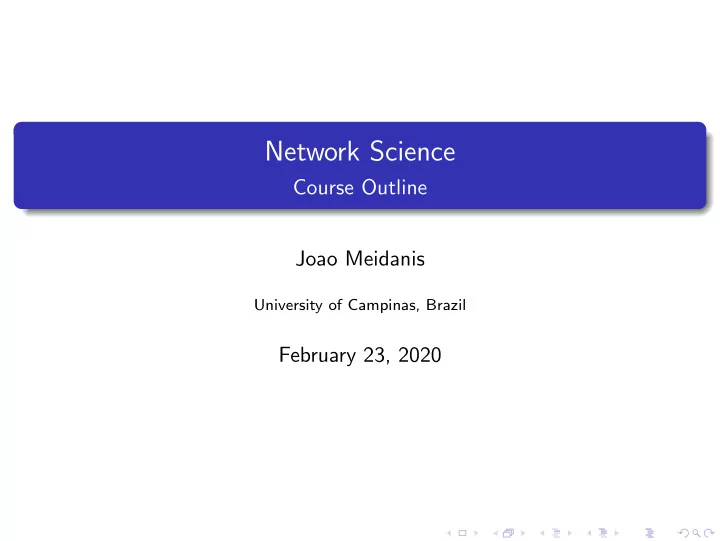

Network Science Course Outline Joao Meidanis University of Campinas, Brazil February 23, 2020
Summary List of Class Students 1 Brief Introductions 2 Course Web Site 3 Book 4 Book Author’s Personal Introduction 5 Meidanis (Unicamp) Network Science February 23, 2020 2 / 24
List of Class Students Meidanis (Unicamp) Network Science February 23, 2020 3 / 24
List of Class Students Each student please provide: Name Program Meidanis (Unicamp) Network Science February 23, 2020 4 / 24
Brief Introductions Meidanis (Unicamp) Network Science February 23, 2020 5 / 24
Brief Introductions Each student please stand up and briefly introduce yourself Meidanis (Unicamp) Network Science February 23, 2020 6 / 24
Course Web Site Meidanis (Unicamp) Network Science February 23, 2020 7 / 24
Course Web Site http://www.ic.unicamp.br/~meidanis/courses/mo412/2020s1/ Meidanis (Unicamp) Network Science February 23, 2020 8 / 24
Book Meidanis (Unicamp) Network Science February 23, 2020 9 / 24
Book Network Science , by Albert-L´ aszl´ o Barab´ asi Cambridge University Press, 2016 https://networksciencebook.com/ Meidanis (Unicamp) Network Science February 23, 2020 10 / 24
Book Author’s Personal Introduction Meidanis (Unicamp) Network Science February 23, 2020 11 / 24
Today and Paths to Success Network Science today (after 15 years): dozens of conferences, workshops, schools per year > 100 books, 3 journals most universities offer courses; one can get a PhD in 3 continents USD hundreds of millions for research Meidanis (Unicamp) Network Science February 23, 2020 12 / 24
SUCCESS 1: Invasion Percolation and Prim’s Algorithm Percolation: liquid flowing through a porous material Prim’s algorithm: grow a minimum spanning tree using the smallest edge going out of the current component Nature paper Figure source: Flickr; author: miheco from California, USA; license: Creative Commons Attribution-Share Alike 2.0 Generic Meidanis (Unicamp) Network Science February 23, 2020 13 / 24
FAIL 1: Second Network Paper Puzzled about networks (e.g, cables in a city) Random graphs , by Bollob´ as The Origins of Order , by Kauffman Second paper inspired by these books: Dynamics of Random Networks: Connectivity and First Order Phase Transitions Rejected by four journals (1995-1997) Science Nature Physical Review Letters Europhysics Letters Meidanis (Unicamp) Network Science February 23, 2020 14 / 24
FAIL 2: Mapping the WWW (or trying to . . . ) Leave random graphs aside Look at real networks Letter to robot researchers asking about WWW degrees No answers Safer research: quantum dots Two grants in 1997 Several students and a pos-doc Asimov’s Foundation inspired network comeback 1998: asked his best student to join — she agreed! Reka Albert joined his group (of two people now) Meidanis (Unicamp) Network Science February 23, 2020 15 / 24
FAIL 3: Small Worlds Two communities studying networks: Social scientists, the six degree of separation idea Mathematicians, with random graphs Watts and Strogatz 1998 paper on small world networks: Collective dynamics of ‘small-world’ networks Compare to FAIL 1 Title: Dynamics of Random Networks: ... Communicating your results Meidanis (Unicamp) Network Science February 23, 2020 16 / 24
SUCCESS 2: Mapping the Web Hawoong Jeong joined the group (three people now) Built a WWW crawler Degree distribution determined Shock: not a Poisson distribution, but a power law WWW is not a random network! Nature paper: “six degrees” is “19 degrees” in WWW Meidanis (Unicamp) Network Science February 23, 2020 17 / 24
SUCCESS 3: Reason for Power Laws (The Discovery) Random network: each node chooses neighbors randomly WWW: new pages tend to link to pages that already have many links This is preferential attachment Simulations showed that growth by preferential attachment lead to networks whose degree distribution follows a power law These are the scale-free networks They also have hubs : nodes with degree much higher than average Many real life networks fit this pattern: actors, computer chip wiring, power grid, . . . Meidanis (Unicamp) Network Science February 23, 2020 18 / 24
SUCCESS 4: Three papers in seven days (The Rush) Nature : The WWW is a scale-free network (19 degrees of separation) Science : Many other networks are scale-free, and preferential attachment is an explanation Physica A : Longer version Had to call the editor of Science to overturn a reject without review decision, and succeeded! Meidanis (Unicamp) Network Science February 23, 2020 19 / 24
Quitting Materials Science Research group: 4 student and 1 pos-doc All but Reka working on surfaces and quantum dots Called a meeting No more materials science 100% networks from now on Two students left The rest joined the new field Meidanis (Unicamp) Network Science February 23, 2020 20 / 24
FAIL 4: Funding (1999) Got new grant for materials science Had to return it: no more interest Submitted a proposal do DARPA Scale-free networks resistant to random failures, but . . . . . . shockingly sensitive to attacks Also wrote paper on that Science rejected paper DARPA rejected proposal Meidanis (Unicamp) Network Science February 23, 2020 21 / 24
SUCCESS 5: Failure versus Attack Failure × attack paper submitted to Nature Accepted! Meidanis (Unicamp) Network Science February 23, 2020 22 / 24
FAIL 5: Nemesis Journey was not without its enemies John Doyle, from Caltech Small world property easier to explain Scale-free property required more work Proof only came in 2001 (Bollob´ as, Riordan, Spencer) Community started to appreciate central role of degree distribution Meidanis (Unicamp) Network Science February 23, 2020 23 / 24
Personal Introduction Summary Highly cited papers, funding, journals Path not straight Collaboration was key ingredient Multidisciplinarity Meidanis (Unicamp) Network Science February 23, 2020 24 / 24
Recommend
More recommend